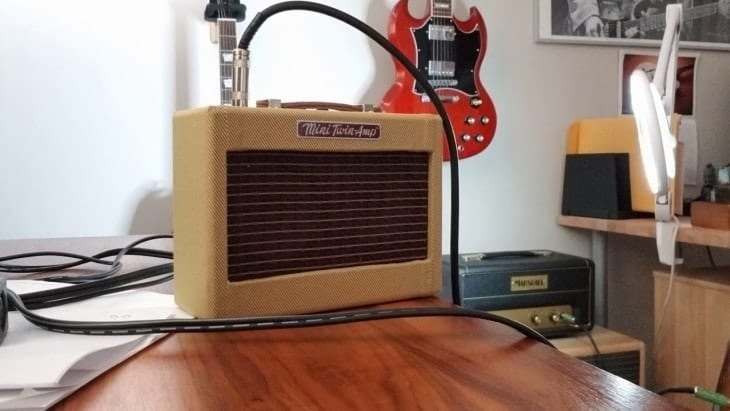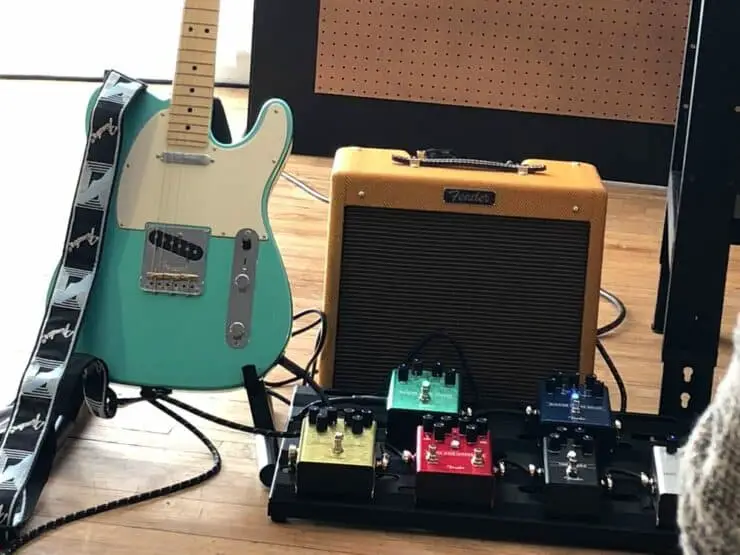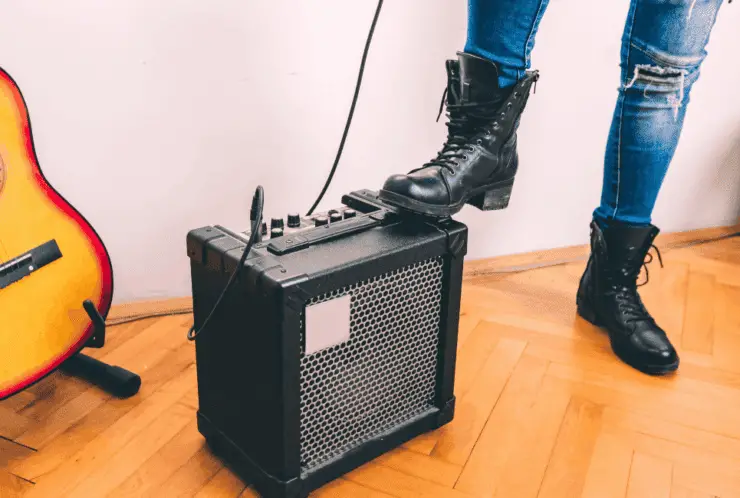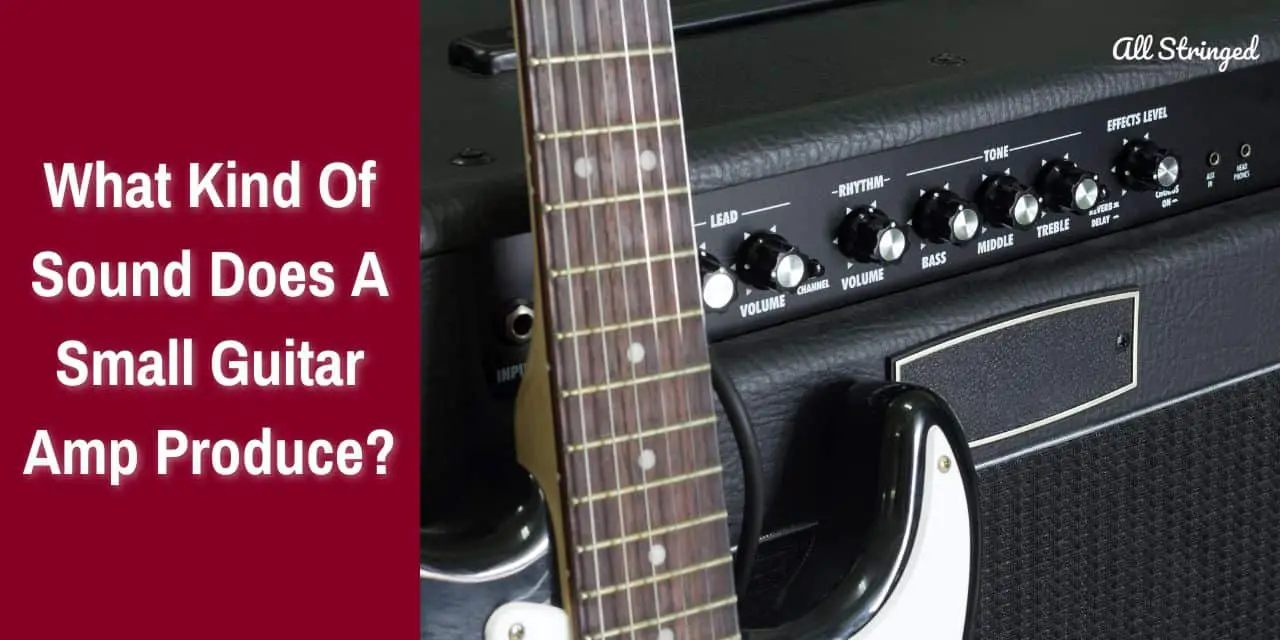Are you looking for a small amp with a big sound? Do you want to know what kind of sound a small guitar amp can produce? If your answer is yes, then this article is for you! We’ll discuss how small amps can produce excellent sound and what you should look for in a small amp to get the best sound. So, if you’re a guitar player, keep reading to find out what kind of sound a small guitar amp can produce!
Overview of small guitar amps
When it comes to playing the guitar, having the right type of amp can be the difference maker. Choosing the right amplifier can greatly enhance your overall sound and playing experience. While large guitar amps are often preferred for stage performances and studio recording, small guitar amps come with their own unique benefits.
>>> Click here to read our review about the Top 15 Best Small Guitar Amps <<<
A small guitar amp, as the name suggests, is a compact and portable amp designed specifically for electric guitars. These amps are typically smaller in size and lower in wattage in comparison to their larger counterparts. Small guitar amps are commonly used for practice sessions, home recordings, small gigs, or situations where portability is important.
There are several benefits of small guitar amps. Some of the most prominent ones include –
#1. Portability
One of the biggest benefits of a small guitar amp is its portability. Small guitar amps are lightweight and quite easy to carry, which makes them ideal for musicians and guitarists on the go. Whether you are going for band practice, a small gig, a jam session with friends, or simply playing at a remote location, small guitar amps will allow you to bring your sound wherever you need.
#2. Space efficiency
Small guitar amps are ideal for people with limited space. If you reside in an apartment, a dorm room, or have a small home studio, a compact amp will consume less room compared to a large guitar amp. It will allow you to have a dedicated practice setup without sacrificing too much space.

#3. Versatility
Despite being smaller in size, most small guitar amps actually offer a surprising amount of tonal versatility. They often feature built-in effects, amp modeling, and various tone-shaping controls. This versatility will allow you to experiment with different sounds and styles, making them an amazing option for beginners and professionals alike.
#4. Practice and recording
Small guitar amps are perfect for practice sessions. They’ll allow you to dial in your preferred tone at lower volumes, making them ideal for home practice without disturbing family members or neighbors. Moreover, many small amps also come with headphone outputs. This means you will be able to practice silently or monitor your playing during late-night sessions. These amps also serve as amazing tools for recording, as their smaller size and lower wattage make them easier to mic up and capture in a studio setting.
#5. Affordability
Smaller guitar amps are generally much more affordable compared to larger amps. This makes them a highly attractive option for beginners or guitarists on a budget. Despite their low price point, many small amps are able to deliver impressive sound quality and functionality.
#6. Experimentation and learning
Small guitar amps offer an excellent platform for experimentation and learning. With their built-in effects, amp modeling, and other tonal options, you’ll be able to explore different sounds, genres, and playing techniques. This versatility encourages creativity and allows you to develop your own unique style as a musician or guitarist.
Different types of small guitar amps
If you’re in the market for small guitar amps, there are numerous options available to suit different preferences and playing styles. Understanding the differences between different types of small guitar amps will help you make an informed decision based on your specific needs. Here are the different types of small amps and their unique characteristics.
#1. Tube amps
Tube amps or valve amps are one of the most popular types of guitar amps. They are best known for their warm and organic sound. These amps make use of vacuum tubes for amplifying the guitar signal. Some of the most prominent characteristics of tube amps include tonal characteristics, natural overdrive and distortion, responsive and dynamic, maintenance and lifespan, and more.
Tube amps produce a natural and dynamic sound with harmonic complexity. They usually excel at delivering warm and vintage tones, making them quite popular among blues, rock, and jazz guitarists. These amps are known for their touch-sensitive response, which means they respond to your playing dynamics and picking technique. This dynamic range will allow for expressive playing and a more interactive experience.
Tube amps produce natural and pleasing overdrive and distortion when pushed to higher volumes. They’re favored for their smooth and musical breakup, creating a desirable crunch and saturation. They require occasional maintenance, including replacing worn-out tubes. However, with proper care, they are able to last for many years and develop a unique character over time.
#2. Solid-state amps
Solid-state amps make use of solid-state electronics, such as transistors and diodes for amplifying the guitar signals. These amps offer their own set of advantages and characteristics. Some of the primary ones include durability, reliability, consistent performance, crisp and clean tones, cost-effectiveness, and more.
Solid-state amps are known for their durability and reliability, which makes them ideal for touring musicians or people looking for a low-maintenance option. They also offer a cleaner and more transparent sound reproduction. They deliver accurate and precise tones, which makes them perfect for genres like country, jazz, and some styles of metal.
Solid-state amps typically feature a consistent sound regardless of volume level, which makes them suited for practice and recording environments where consistency is important. Solid-state amps are much more affordable than tube amps, which makes them a budget-friendly option for beginner guitarists or musicians on a tight budget.

#3. Digital modeling amps
Digital modeling amps make use of advanced digital technology for simulating the sound of various amps and effects. These amps offer extensive tonal versatility and flexibility among other features like portability, compactness, recording and direct integration, and more.
Digital modeling amps come with a wide range of amp models, effects, and tone-shaping capabilities. These amps will allow you to simulate the sounds of different amps, cabinets, and effect pedals, giving you an impressive array of tones at your fingertips. These amps typically come in small, lightweight packages, which makes them highly portable and convenient for gigging or recording on the go.
Digital marketing amps often come with direct recording capabilities, USB connectivity, and headphone outputs. This will result in seamless integration with recording software and makes them ideal for home recording setups. Many digital modeling amps include built-in metronomes, backing tracks, and other practice features that can help in learning and improving your playing skills.
How to get the most out of a small guitar amp
While small guitar amps offer portability and convenience, there are numerous ways you can enhance their sound and expand their capabilities. By knowing certain techniques, you will be able to unlock a world of tonal possibilities and maximize the potential of your small guitar amp. Here are some of the techniques that will help you get the most out of your small guitar amp.
#1. Adjusting tone controls
Tone controls like bass, midrange, and treble knobs are important tools for shaping your guitar’s sound. You can utilize adjusting tone controls effectively by experimenting, boosting or cutting frequencies, considering the amp’s character, and more.
Start off by setting all tone control to their neutral or halfway positions. You must play your guitar and gradually adjust each control to hear how it affects the tone. You should experiment with different settings to find the desired balance and character.
The bass control adjusts the lower frequencies, giving you more warmth and depth. The midrange control affects the mid frequencies, shaping the guitar’s presence and punch. The treble control will influence the higher frequencies, adding brightness and clarity. You should adjust the controls to emphasize or reduce specific frequency ranges based on your playing style and the sound you wish to achieve.
Moreover, each amp comes with its own unique tonal characteristics. Some small guitar amps might have a darker or brighter inherent tone. Take this into account when you’re adjusting the tone controls to work in harmony with the amp’s natural sound.
#2. Using effect pedals
Effect pedals can greatly expand the sonic possibilities of your small guitar amp. You must go for some of the popular types of effect pedals like overdrive/distortion pedals, modulation pedals, and time-based effects. You need to incorporate them into your setup and get the most out of your amp.
Overdrive/distortion pedals add grit, saturation, and various levels of distortion to the sound. They’re able to simulate the crunch of a tube amp or deliver heavier distortion for genres like metal or rock. Modulation effects like chorus, phaser, and flanger create spatial and dynamic shifts in your sound. They’ll add depth, movement, and texture to your playing.
Time-based effects like delay and reverb pedals create spatial ambiance and add depth to the sound. Delay creates echoes and repeats of your playing whereas reverb simulates different room sizes and environments. There are several other effect pedals available, such as wah-wah, tremolo, and octave pedals. Each one of them offers unique sonic possibilities. You must explore different pedals for finding the ones that complement your style and expand your sonic palette.
#3. Setting up a pedalboard
A well-organized pedalboard will ensure easy access to your effect pedals and streamline your signal chain. There is a series of steps you must follow to set up a pedalboard –
Begin by understanding the order in which your pedals have to be connected. Generally, the signal flows from the guitar to the tuner pedal, followed by dynamics pedals, overdrive/distortion pedals, modulation effects, time-based effects, and lastly, the output to the amp.
Make sure that you have a reliable power supply to provide sufficient voltage and current for your pedals. Use a dedicated power supply or isolated pedalboard power as it can minimize noise and ensure consistent performance. Further, use high-quality cables to connect your pedals, minimizing signal loss and unwanted noise. You should neatly organize and secure the cables to avoid tripping hazards and accidental unplugging.
Arrange the pedals in a logical and ergonomic order, considering the frequency of use and footswitch accessibility. You should experiment with different pedal combinations and order for finding the most pleasing and efficient setup for your desired tones.
What kind of sound does a small guitar amp produce?
Small guitar amps are rather small and compact in size but they are still capable of producing a wide range of tones to suit various musical styles and preferences. Whether you are looking for clean sounds, overdrive tones, or distorted tones, small guitar amps will definitely deliver what you are looking for. Here, you will get to know what kind of sound does a small guitar amp produce and the sonic possibilities available.
Clean tones
Clean tones are characterized by a clear and undistorted sound, delivering a pure representation of your guitar’s natural tone. Small guitar amps can produce beautiful tones that are ideal for genres like jazz, pop, and country. These amps excel at reproducing the subtle nuances and articulation of your playing. The clean tones are crisp, articulate, and well-defined, allowing each tone to ring out with clarity.
They also typically have a lower wattage, which means they might have less headroom compared to larger amps. Headroom refers to the ability of an amp to maintain clean tones at higher volumes without distortion. Small guitar amps might reach their maximum clean volume relatively quickly, which can be advantageous for intimate settings or recordings that require a more controlled sound.
Small guitar amps also offer great dynamic responsiveness, which means they respond well to changes in your picking technique and playing dynamics. This allows for more expressive playing and the ability to achieve a wide range of tonal variations by adjusting your playing style.
Overdriven tones
Overdriven tones generally occur when a small amount of natural tube saturation is introduced into the signal chain, resulting in a smooth and warm breakup. Small guitar amps are able to produce sweet, singing overdrive tones that are covered by rock, blues, and classic rock guitarists. Small guitar amps exhibit a natural warmth when they’re pushed into mild overdrive. The resulting sound will be smooth, rich, and often described as “creamy”. Overdriven tones offer increased sustain and a pleasing compression that enhances the harmonic content of your playing.
Small guitar amps are known for their touch sensitivity, which means they respond to the subtle nuances of your playing technique. The amount of overdrive can be controlled by adjusting the picking dynamics and guitar volume, providing a dynamic and expressive playing experience.
Overdriven tones from small guitar amps often possess harmonic complexity, adding depth and character to the sound. The harmonics interact with each other in a musical and pleasing way, creating a signing and expressive quality.
Distorted tones
Distorted tones are characterized by raw, aggressive, and heavily saturated sounds that are commonly associated with genres like metal, hard rock, and punk. Small guitar amps can deliver powerful distorted tones with their own unique characteristics like crunch, aggression, definition, compression, sustain, and more.
Small guitar amps can produce a crunchy and aggressive distorted tone when driven hard. The sound will be characterized by a raw and gritty quality that adds a level of intensity and edge to your playing.
Despite the heavy distortion, small guitar amps also maintain good note articulation and definition. Each note remains distinguishable within the wall of sound, allowing for clarity and precision even in high-gain situations.
Distorted tones from small guitar amps often exhibit increased compression and sustain, allowing the notes to ring out with power and intensity. The compressed nature of the sound could enhance the overall punch and attack of your playing.

How is the sound produced from a small amp different from what large amps produce
When it comes to guitar amps, size matters to an extent. Small and large guitar amps come with distinct characteristics in terms of sound production. While small guitar amps are known for their convenience and portability, large guitar amps provide power and versatility. It’ll be important to explore the differences in sound production between small and large guitar amps, helping you understand the unique qualities each size offers.
Power and volume
One of the biggest differences between small and large guitar amps is their power and volume capabilities. Small guitar amps typically come with lower wattage ratings, resulting in lower power output and consequently, lower volume levels. These amps are well-suited for home practice, studio recordings, and small venues. They deliver ample volume for personal use but might struggle to compete with drums and loud bands in larger live settings.
Meanwhile, large guitar amps boast higher wattage ratings, allowing for greater power output and higher volume levels. They are designed to deliver robust sound and project well in larger venues and live performances. Large guitar amps have the advantage of producing louder and more authoritative tones, making them suitable for gigs and concerts where significant volume is needed.
Tonal range and depth
The size of the amp can also impact the tonal range and depth of the sound produced. Small guitar amps often come with a distinct tonal character, offering a tighter and more focused sound. They tend to emphasize the midrange frequencies, resulting in a punchy and present tone. While they can produce clean and overdriven tones with clarity, they might have limitations in terms of low-end response and overall depth.
Large guitar amps, on the other hand, have a broader tonal spectrum and typically offer a more rounded and full-bodied sound. They deliver a wider frequency response, allowing for extended lows, pronounced mids, and detailed highs. Large guitar amps excel at reproducing a wide range of tones, from pristine cleans to thick, overdriven sounds. They also deliver a more immersive playing experience with their expansive tonal depth.
Dynamics and response
Another major aspect where small guitar amps and large guitar amps differ is in their dynamics and response to playing dynamics. Small guitar amps are often known for their enhanced touch sensitivity and responsiveness. They excel at capturing the nuances of your playing style and respond dynamically to changes in picking technique and guitar volume. Small guitar amps can deliver expressive and response tones, allowing for subtle variations in dynamics and articulation.
Large guitar amps offer a different level of dynamics as they’re capable of handling greater headroom and higher volume levels. These amps can produce a more aggressive and assertive response to your playing, ideal for genres that need greater impact and force. Large guitar amps often offer more control over the dynamics, allowing for wider tonal variations with aggressive pick attack and greater control over sustained notes.
FAQs
What kind of sound does a small guitar amp produce?
Small guitar amps typically produce a clean, balanced sound with a moderate amount of volume. They are usually designed for practice and small gigs, and are usually not powerful enough for larger venues. Small guitar amps are often solid-state amps, and they may also feature effects such as distortion and reverb.
What is the difference between a small guitar amp and a large guitar amp?
A small guitar amp is typically designed to produce a moderate volume level, while a large guitar amp is designed to produce a louder and more powerful sound. Small guitar amps are generally not powerful enough to fill a large venue or be heard over a loud band, and they may not have the same features or sound quality as a larger amp.
What should I consider when choosing a small guitar amp?
When choosing a small guitar amp, it’s important to consider your budget, the type of sound you’re looking for, and any additional features you may need. It’s also important to consider the size of the amp and whether it is portable enough for your needs. Small guitar amps can be a great option for practice and small gigs, so make sure to find the right amp for your needs.



